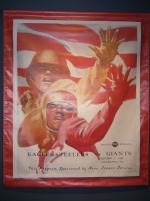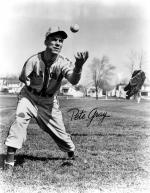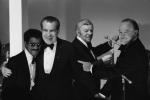![header=[Marker Text] body=[Composer, author, arranger, and conductor of "The Band of Renown," a popular and long-running act. His hit song "Sentimental Journey" symbolized a period when WWII veterans were returning home. Brown and his band had a long association with comedian Bob Hope and his USO shows. ] sign](http://explorepahistory.com/kora/files/1/10/1-A-2F0-139-ExplorePAHistory-a0k4y1-a_450.jpg)
Mouse over for marker text
Name:
Les Brown [World War II]
Region:
Poconos / Endless Mountains
County:
Schuylkill
Marker Location:
1944 E Grand Ave., Reinerton
Dedication Date:
March 14, 2006
Behind the Marker
"It's difficult to find a better liked and more respected leader in the entire dance band business than Les Brown," wrote music columnist George Simon in 1940. "Of course, a healthy personality and an honest character don't make a great leader by themselves. But they help an awful lot when the guy can do other things such as make fine arrangements, rehearse and routine a band intelligently, treat men as they want to be treated, and then impress himself on the public by playing a good clarinet."
In 1940, Les Brown and his band were at the height of their popularity. When World War II began, they signed on with Coca-Cola to play on a radio show that originated in military bases around the country. Lead singer Doris Day came back to the band after leaving to get married and become a mom, and her hits were wowing the country. In 1945, Day's rendition of Brown's "Sentimental Journey" remained the number one hit for an amazing seventeen weeks, echoing the hopes of thousands of families as their servicemen came home after hostilities ceased.
Big bands dominated the Billboard charts and the radio airwaves during the Second World War. On the front lines of the war and at home, GIs and their families listened music of Benny Goodman, Duke Ellington, Les Brown, Glenn Miller, and the Dorsey brothers. Musicians were drafted or volunteered, and bands adjusted their music and their itineraries to meet the needs of a nation at war. Musicians and other entertainers in the military could enter Special Services units, which utilized their talents to entertain the troops and to keep morale high. Many signed up to do war bonds tours to boost the sales of bonds nationwide. The United Service Organizations (USO) used hundreds of stars to travel to distant bases across the globe to entertain the men and women in uniform.
Dorsey brothers. Musicians were drafted or volunteered, and bands adjusted their music and their itineraries to meet the needs of a nation at war. Musicians and other entertainers in the military could enter Special Services units, which utilized their talents to entertain the troops and to keep morale high. Many signed up to do war bonds tours to boost the sales of bonds nationwide. The United Service Organizations (USO) used hundreds of stars to travel to distant bases across the globe to entertain the men and women in uniform.
Two of the highest-profile stars who volunteered for military service were Clark Gable and Pennsylvania's own Jimmy Stewart. After his actress wife Carole Lombard was killed in a plane crash, Gable joined the Army Air Corps and flew five combat missions over Germany, filming the raids as part of a documentary on aerial gunners. The Nazis put a price on Gable's head, offering a reward to any pilot who shot down his B-17. Stewart was initially rejected because he was too skinny, even though he was already an accomplished flier. Undeterred, Stewart bulked up and like Gable, went into the Air Corps, piloting B-17s in twenty combat missions over Germany.
Jimmy Stewart. After his actress wife Carole Lombard was killed in a plane crash, Gable joined the Army Air Corps and flew five combat missions over Germany, filming the raids as part of a documentary on aerial gunners. The Nazis put a price on Gable's head, offering a reward to any pilot who shot down his B-17. Stewart was initially rejected because he was too skinny, even though he was already an accomplished flier. Undeterred, Stewart bulked up and like Gable, went into the Air Corps, piloting B-17s in twenty combat missions over Germany.
Other Pennsylvania-born entertainers had varied careers during the war. Too old for service, veteran actor and swimmer Johnny Weissmuller instructed sailors on how to hold their breaths under water and how to swim away from burning oil and gas. Aspiring Philadelphia tenor
Johnny Weissmuller instructed sailors on how to hold their breaths under water and how to swim away from burning oil and gas. Aspiring Philadelphia tenor  Mario Lanza was drafted and became an indifferent soldier, winding up as a military policeman stationed on the Mexican border. A would-be coal miner from Pennsylvania named Volodymyr Palahniuk went into the military in hopes of becoming a pilot. While training in the Southwest, he crashed in a B-24 and was badly burned. After the war and extensive rehabilitation, he decided instead to become an actor, and, under the name Jack Palance, used his craggy face to good effect, becoming one of Hollywood's most successful character actors.
Mario Lanza was drafted and became an indifferent soldier, winding up as a military policeman stationed on the Mexican border. A would-be coal miner from Pennsylvania named Volodymyr Palahniuk went into the military in hopes of becoming a pilot. While training in the Southwest, he crashed in a B-24 and was badly burned. After the war and extensive rehabilitation, he decided instead to become an actor, and, under the name Jack Palance, used his craggy face to good effect, becoming one of Hollywood's most successful character actors.
Even professional sports were deeply affected by the war. More than 4,000 of 5,700 baseball players in the major and minor leagues went into the service, including stars like Ted Williams. When baseball's commissioner offered to suspend the pastime for the duration, President Roosevelt said no, because baseball was a national sport and its continuance was good for morale. As a result, the pros scraped the bottom of the barrel for players to keep their teams going. Even the one-armed Pete Wyshner, aka Pete Grey, managed to play for the St. Louis Browns in 1945, serving as an inspirational example for returning disabled servicemen. Football was equally affected; both the Pittsburgh Steelers and Philadelphia Eagles were so shorthanded that in 1943 the teams combined for the season. Known as the "Steagles," they finished a respectable 5-4-1.
Pete Wyshner, aka Pete Grey, managed to play for the St. Louis Browns in 1945, serving as an inspirational example for returning disabled servicemen. Football was equally affected; both the Pittsburgh Steelers and Philadelphia Eagles were so shorthanded that in 1943 the teams combined for the season. Known as the "Steagles," they finished a respectable 5-4-1.
After World War II, many entertainers continued to entertain American servicemen, especially through the USO. In 1947, Brown teamed up with Bob Hope. For the next forty years, he was the comedian's music director on radio, television, and eighteen overseas tours for the USO.
Les Brown loved was playing the music that lifted folks, young and old, out of their seats and onto the dance floor. He lifted them on dozens of recordings, at inaugural fetes for Richard Nixon and Ronald Reagan, at a gala hosted by Frank Sinatra for England's Queen Elizabeth, at countless public ballrooms and private parties, and, finally, at the age of 88, for the student body at California's Citrus Community College, less than three months before his death on January 6, 2001.
To learn more about Les Brown's career, click here.
click here.
"It's difficult to find a better liked and more respected leader in the entire dance band business than Les Brown," wrote music columnist George Simon in 1940. "Of course, a healthy personality and an honest character don't make a great leader by themselves. But they help an awful lot when the guy can do other things such as make fine arrangements, rehearse and routine a band intelligently, treat men as they want to be treated, and then impress himself on the public by playing a good clarinet."
In 1940, Les Brown and his band were at the height of their popularity. When World War II began, they signed on with Coca-Cola to play on a radio show that originated in military bases around the country. Lead singer Doris Day came back to the band after leaving to get married and become a mom, and her hits were wowing the country. In 1945, Day's rendition of Brown's "Sentimental Journey" remained the number one hit for an amazing seventeen weeks, echoing the hopes of thousands of families as their servicemen came home after hostilities ceased.
Big bands dominated the Billboard charts and the radio airwaves during the Second World War. On the front lines of the war and at home, GIs and their families listened music of Benny Goodman, Duke Ellington, Les Brown, Glenn Miller, and the
Two of the highest-profile stars who volunteered for military service were Clark Gable and Pennsylvania's own
Other Pennsylvania-born entertainers had varied careers during the war. Too old for service, veteran actor and swimmer
Even professional sports were deeply affected by the war. More than 4,000 of 5,700 baseball players in the major and minor leagues went into the service, including stars like Ted Williams. When baseball's commissioner offered to suspend the pastime for the duration, President Roosevelt said no, because baseball was a national sport and its continuance was good for morale. As a result, the pros scraped the bottom of the barrel for players to keep their teams going. Even the one-armed
After World War II, many entertainers continued to entertain American servicemen, especially through the USO. In 1947, Brown teamed up with Bob Hope. For the next forty years, he was the comedian's music director on radio, television, and eighteen overseas tours for the USO.
Les Brown loved was playing the music that lifted folks, young and old, out of their seats and onto the dance floor. He lifted them on dozens of recordings, at inaugural fetes for Richard Nixon and Ronald Reagan, at a gala hosted by Frank Sinatra for England's Queen Elizabeth, at countless public ballrooms and private parties, and, finally, at the age of 88, for the student body at California's Citrus Community College, less than three months before his death on January 6, 2001.
To learn more about Les Brown's career,










